CHIEF EXECUTIVE'S REVIEW 2007

Tongaat Hulett has continued to grow profits from operations in 2007 and to build its competitive position as an agri-processing business which includes integrated components of land management, property development and agriculture. Profit from Tongaat Hulett’s continuing operations increased by 15 percent to a record R838 million.
The year included the completion of a corporate restructure and, at the end of June 2007, The Tongaat-Hulett Group unbundled its shareholding in Hulamin to its shareholders following the listing of Hulamin on the JSE to establish two focused, separately listed entities in the form of Tongaat Hulett and Hulamin. The corporate structuring transactions included BEE equity participation in both Tongaat Hulett and Hulamin and a Tongaat Hulett share repurchase. Tongaat Hulett was confirmed as a top performer in the area of transformation when it was awarded Level Three Contributor status in terms of the broad based South African BEE Scorecard, which entitles its customers to recognise 110 percent of their procurement spend with the company.
In this period, a number of factors impacted, both positively and negatively, on the business. Some of the more significant issues included a shortage of unconditional developable land stock, improved market prices of land in the eThekwini area, the small South African sugar crop, maize input costs at import parity levels, the national energy crisis and difficult conditions in Zimbabwe.
The systematic positioning over a number of years of the operations and the leveraging of the synergies that exist between the agri-processing operations and prime agricultural landholdings have created a single focused entity with the commitment, expertise, ability and platform to benefit from opportunities that the changing global agriculture, land, energy and trade environments are creating for Southern Africa. During the latter part of 2007, the benefit of the increased focus and related actions in the business became increasingly evident, which is important going into 2008 and building towards 2009. It is pleasing to note the progress made in many areas with the emphasis going forward being placed on increasing unconditional developable land stock, land development opportunities around the new international airport at La Mercy, positioning the starch operations to benefit from a more competitive maize position, the expansions in Mozambique, restoration of production in Zimbabwe and improving cane supplies in South Africa. In the cane processing operations, attention is focused on increasing realisations from bagasse, molasses and tops and trash, with opportunities emerging in power generation and bio-ethanol production.
TONGAAT HULETT’S COMPETITIVE POSITION IN A CHANGING WORLD OF AGRICULTURE
Review of Global Environment
The structural changes in agricultural markets gained momentum in 2007, with demand for renewable energy sources increasing. Adding impetus to this was the strong growth in food demand, particularly in developing countries such as China and India, driven by changes in dietary habits as people become more affluent and population numbers increase. The interrelationships between crops, such as soya and other edible oils, maize, cassava, wheat and sugar are increasing as farmers and agri-processors are confronted by choices as to which crops to farm and process based on their relative profitability. Tongaat Hulett with its portfolio of agriprocessing assets is well positioned in this world of increasing demand for agricultural products.
World sugar prices, following initial increases to over 19 US cents per pound in early 2006 declined during 2007 to a low of 8,5 US cents per pound on concerns of a rise in production in India. Since then, in early 2008, prices have recovered to current levels of 14,5 US cents per pound. Following previous World Trade Organisation (WTO) rulings on European sugar exports, pressure continues to be applied for market reforms in the European Union (EU) with the recent announcement of an increase in the incentives for sugar beet growers to exit the market. This, coupled with additional demand from renewable energy and the value against the US dollar of the currencies of key producers, such as Brazil and India, is expected to result in increases in the world sugar price over the medium term.
In international maize and edible oil markets, prices have more than doubled since the end of 2005, driven particularly by demand for biofuels. This trend was reinforced by the recent signing of the new energy bill in the United States that places further pressure on maize supply to ethanol, leading to the expectation that demand for maize over the next five years will continue to increase. The higher world maize price is driving increases in world starch and glucose prices and is leading to South African maize farmers becoming more profitable, even at prices close to export parity. This trend is expected to support improved margins in the production of starch-based products.
The growth in demand for agricultural products, coupled with an increase in competition for alternative land usage due to increasing urbanisation and tourism growth, is resulting in an increase in the significance of agricultural land in many countries. In such an environment, Tongaat Hulett continues to benefit from increases in its land values and earnings generated from its landholdings utilising the competencies developed to manage all facets of land, including agriculture and agri-processing operations and the transition to property development.
Expanding Sugar Production to Benefit from Improved Access to Attractive Markets
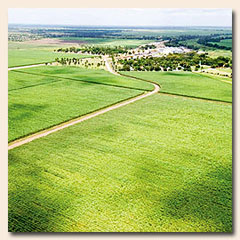
The evolving world sugar fundamentals continue to support Tongaat Hulett’s strategy of growing its earnings through sugar expansions in low cost regions with access to the attractive European markets at market realisations above current world prices. In these evolving markets, the focus in the sugar operations is to increase sugar production from the current level of 1 119 000 tons in 2007. Milling capacity will be in excess of 1 945 000 tons in the 2009/10 season after the completion of the expansion of the Xinavane mill in Mozambique. The constraint to maximise milling capacity utilisation has shifted to cane availability. In addition to previous WTO rulings, the long-standing sugar protocols between the EU and ACP (African, Caribbean and Pacific) countries are to terminate on 30 September 2009. These protocols will be replaced by economic partnership agreements that will facilitate a doubling in imports of sugar into the European Union to 3,5 million tons per annum.
Land Management and Property Development
The significance of Tongaat Hulett’s landholdings within the SADC region, particularly the prime locations within the city limits of eThekwini and the coastal areas south of the Tugela River, require an effective land management and property development approach. These landholdings provide cane to the sugar cane processing operations and are an integral part of the strategies that seek to increase the supply of cane to the mills and manage the various dynamics affecting cane, including seeking productive resolution of land claims in areas of cane supply. The realising of value from a development perspective takes place in a co-ordinated and phased approach when conditions are appropriate. Tongaat Hulett has the competence and platform to maximise value over time in all phases of land usage - from acquisition, agriculture and agriprocessing to the transition to property development.
Increasing Importance of Renewable Energy in the Agricultural Value Chain
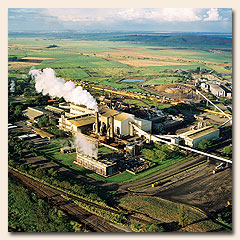
As the trend towards the integration of agriculture and energy continues on a global basis, Tongaat Hulett’s mix of assets and geographic locations are likely to lead to an increasing component of its earnings being derived from the production of renewable energy in the form of biofuels and cogeneration of electricity. In Brazil, the fastest growing sugar industry in the world, a clearly defined government strategy that provided a clear framework and support has resulted in the establishment and viability of a significant sugar cane industry where the integrated renewable energy component has been a key part of its success.
Renewable energy in the Southern African sugar industry will be a key element for the growth and long-term viability of millers and growers as it should create opportunities for increased realisations from bagasse and molasses. Tongaat Hulett’s sugar mills in Southern Africa, operating at full capacity, would have the potential to generate approximately 660MW of electricity using current technologies if they were to utilise all the bagasse and two thirds of the tops and trash from the cane supplied to the mills. This would have the environmental benefit of saving 2 million tons of coal annually and reducing CO2 emissions by 4,25 million tons in season.
Recognising the crucial short-term supply side role of cogeneration, the South African government has announced its intention to utilise all viable project proposals that Eskom receives from the private sector in response to its request for proposals. Current indications are that Eskom will look to acquire at least 3 500MW of electricity from private sector cogeneration projects by 2012 with incentives in place for projects able to provide electricity by 2009/10. In 2007, Tongaat Hulett supplied 5MW during the crushing season into the South African national grid.
During December 2007, the South African Cabinet approved the biofuels industrial strategy. The strategy envisages an initial five-year pilot stage with a target to achieve a 2 percent or 400 million litres per annum penetration of the national liquid fuel supply. Following concerns surrounding food security in South Africa, maize was excluded as a raw material for biofuel production. The current biofuels strategy is silent on the mandatory blending of ethanol, recognised in other areas of the world to be a critical success factor in establishing a viable biofuels sector.
Value Added Products and New Product Development
In starch, one of nature’s most versatile raw materials, and in sugar, arguably nature’s most efficient source of carbohydrate, Tongaat Hulett has the platform for a variety of downstream products. During 2007, a more integrated approach to product development between the sugar and starch operations was implemented with a number of significant opportunities under investigation. Arising from the development of the WSM technology currently being enhanced at the slipstream plant at Felixton, a project to produce high purity fructose products from various sugar streams has been developed. A commercial plant is under construction at the sugar refinery and is due for commissioning in the second quarter of 2008 with plans for a larger plant being developed.
The development of Zeba®, a starch-based hydropolymer product used as a soil amendment agent that is able to retain and release water and nutrients is progressing well, with an additional extensive round of agricultural trials being implemented in the 2007/08 summer season.
In its starch and glucose operation, Tongaat Hulett continues to implement projects to grow the sales of higher value products. During 2007, specialised glucose sales grew by more than 8 percent, pre-gelatinised starch sales by 20 percent and sales to the adhesive markets grew by 33 percent. In the last quarter of 2007, the installation of a second pre-gelatinisation plant at the Meyerton mill was approved, with commissioning due in mid-2008.
FINANCIAL RESULTS FOR 2007
Tongaat Hulett’s profit from continuing operations in 2007 increased by 15 percent to R838 million (2006: R726 million).
Operating profit from property developments increased by 32 percent to R428 million (2006: R325 million) with additional capital profits of R48 million (2006: R26 million) being realised. 83 hectares of developable land were sold in 2007 in the Umhlanga Ridgeside, Izinga, Kindlewood, Ilala Ridge, Umhlanga Ridge Town Centre, RiverHorse Valley Business Estate, Bridge City, Briardene and Zimbali Coastal Resort developments. Late in 2007, the Umhlanga Ridgeside development framework plan consisting of 140 hectares was approved.
Profit from sugar operations was R360 million (2006: R356 million), with the Zimbabwean operations being accounted for on a dividend received basis only. Total sugar production in 2007 was 1,119 million tons (2006: 1,067 million tons, before the acquisition of Hippo Valley). The factors affecting production levels are explained in the Review of Operations and include the significant reduction in the South African sugar crop in 2007. The five operations in Mozambique, Zimbabwe and Swaziland contributed R176 million (2006: R99 million) to profit from operations.
Profit from starch operations was R105 million in 2007 (2006: R96 million). Margins remained under pressure with maize input costs being at import parity levels for a significant portion of the year. The last quarter saw improvements in international starch and glucose margins as markets responded to higher raw material costs. Sales volumes in the domestic market grew by 6 percent driven by strong growth across the alcoholic beverage, coffee and creamer, confectionery, mining and prepared foods sectors. Capacity optimisation and efficiencies at operations improved during the second half of 2007 as equipment upgrades and reliability initiatives started to yield benefits.
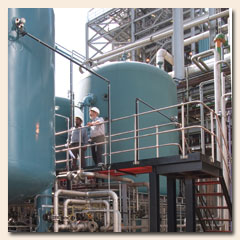
Pursuant to the listing and unbundling of Hulamin, Tongaat Hulett’s 50 percent share in Hulamin was fair valued through the income statement by R3,348 billion in June 2007 and thereafter unbundled as a distribution in specie. Hulamin’s net profit of R42 million, excluding the valuation gain, for the period up to the unbundling is reflected as a discontinued operation.
The corporate transactions concluded by Tongaat Hulett in 2007 included a 25 percent BEE equity participation and a return of capital to shareholders by way of a share buy-back. The cost of the 18 percent BEE equity participation was measured and recognised at the grant date in June 2007, resulting in a once-off IFRS 2 cost of R320 million being charged to the income statement. The IFRS 2 costs relating to the 7 percent BEE employee transaction will be amortised over five years and commenced in the second half of 2007 with a cost of R13 million having been recorded. Once-off transaction related costs of R50 million have also been brought to account. The share buy-back, totalling R506 million including STC, was implemented in July 2007. The once-off BEE and transaction costs are not tax deductible.
The full details of all the corporate transactions concluded in 2007 were included in the circular to shareholders and were approved with a 99 percent vote in favour at a general meeting of shareholders held on 11 June 2007, where 84 percent of shareholders were represented. The financial effects of the transactions as recorded in the 2007 annual financial statements are consistent with the detailed analysis contained in the circular to shareholders. The 2006 annual report provided detail and rationale for the transactions. Further detail is provided in the accounting policies and framework section of the 2007 annual financial statements, as well as in the notes to the annual financial statements.
Tongaat Hulett’s cash flow from operations in 2007 includes cash generated of R970 million, tax payments of R293 million and an increase in working capital of R175 million.
Net finance costs were R119 million. The R88 million net finance income in 2006 in the Tongaat Hulett segment of the income statement includes finance income related to the Hulamin finance structure while the Hulamin discontinued operation segment includes finance costs. Finance costs in 2007 were affected by higher net borrowings and higher interest rates.
Net borrowings, after taking into account cash, as disclosed on the consolidated balance sheet amount to R991 million and include the effects of normal cash flow movements during the year, dividends paid and the impact of the share buy-back. The balance sheet reflects the consolidation of the debt in the BEE equity participation entities, as required by International Financial Reporting Standards. This BEE debt has no recourse to Tongaat Hulett and will effectively be equity settled.
Taking the aforementioned into account, attributable net profit totalled R3,457 billion. Headline earnings were R61 million, which includes the once-off transaction costs and BEE IFRS 2 costs and excludes the Hulamin fair valuation. The 2006 headline earnings of R703 million included the Hulamin contribution for a full year.
The Board has declared a final dividend of 160 cents per share, which brings the total annual dividend to 310 cents per share for the new Tongaat Hulett.
REVIEW OF TONGAAT HULETT OPERATIONS
Tongaat Hulett has the advantage of owning a compelling mix of agri-processing assets in Southern Africa with access to attractive markets. It continues to follow an expansion path that favours large-scale agriculture and agri-processing operations in selected countries, given the importance of understanding and establishing social, political and community support in Africa and the associated land and water management requirements. Through its South African sugar and starch and glucose operations, it produces almost half of the refined carbohydrates manufactured in South Africa. Its four significant operations in Mozambique and Zimbabwe are located in agricultural areas that represent some of the lowest cost sugar production regions in the world.
Starch and Glucose
Maize Procurement
As worldwide demand for food increases and an increasing proportion of food crops are diverted to renewable energy, global food commodity stocks, such as maize, are declining. The low stock levels combined with a limited ability to increase the area of land available to agriculture has lead to increases in the international price of maize to levels at which the South African agricultural industry is competitive. This is evident in the increased South African plantings for the 2007/08 maize season which, coupled with good early season rains, is increasing the competitiveness of the starch and glucose operations.
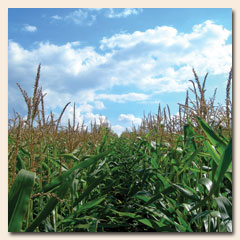
Tongaat Hulett secures its physical supply of non-genetically modified maize through direct contracting with farmers and contracting for delivery with selected grain traders. The physical supply for the rest of the 2007/08 season and the bulk of the supply for the 2008/09 season has been contracted.
The pricing of the maize is delinked from the physical supply utilising two methods, namely toll manufacturing arrangements with selected customers where the final product price reflects the maize input costs, and the back-to-back contracting approach in which the maize is priced at the time the final product price is agreed with a customer. These approaches effectively eliminate the risk of profit volatility that could arise from valuation adjustments on maize. The back-to-back method does not eliminate the profit volatility which arises due to the relative prices of South African maize compared to the world prices. A mechanism that could potentially lock in local maize prices at levels competitive with world prices for longer periods is currently being concluded.
Following a second consecutive small maize crop in South Africa (7,125 million tons), maize prices traded at or near to import parity for the major part of the 2007 financial year. International maize prices, which rose significantly in September 2006 from US$90-100 per ton to levels above US$170, continued to trade in a range of US$125-180 per ton for most of the year, averaging around US$150 per ton, with a sharp increase to US$180 per ton late in December 2007. These high levels, combined with South African maize prices close to import parity, resulted in significantly increased maize costs for 2007. At the end of 2007, Tongaat Hulett had priced 35 percent of its maize for the 2008 financial year against contracts with customers.
Local Market

Tongaat Hulett Starch experienced good demand for its products in 2007, with local market volumes growing by 6 percent. The business continued to hold its own against strong import competition and made further progress in gaining market share. Following its growth in 2006, a strong performance was delivered by the confectionery sector that grew by 11 percent. Other sectors which performed particularly well were spray drying (coffee creamers and instant coffee), up 16,6 percent, paper converting, up 17,3 percent, and prepared foods which was up 13,3 percent. Projects to grow the sales of higher value products continue to be implemented and during 2007, maltodextrin sales grew by more than 7,8 percent, pre-gelatinised starch sales by 20,4 percent and sales to the adhesive markets grew by 33 percent.
During the last quarter of 2006, international starch and glucose prices began to respond to the increase in international maize prices. This trend continued into 2007, resulting in significant price increases in these products in the South African market. In particular, the general trend in international agricultural commodity prices resulted in significant price increases in co-products during the latter part of 2007, helping to offset the increase in maize costs. The impact of higher agricultural commodity prices is still not fully reflected in the price of downstream products.
Export Markets

The high price of South African maize, relative to international maize prices, continued to render Tongaat Hulett uncompetitive in most international markets in 2007. Export volumes reduced by a further 20 percent following a 50 percent reduction in 2006 and margins remained under pressure in those markets which it continued to service. In order to improve its position in international markets, a new entity, Tongaat Hulett Starch Australia was established in 2007 to enable more effective trading into this attractive region. In addition, new agents in a number of Far East countries were engaged. These initiatives are expected to improve Tongaat Hulett Starch’s ability to take advantage of export opportunities as the underlying maize fundamentals improve. Much of the focus is on higher value products that are less sensitive to the maize price.
Cost Management, Efficiencies and Capacity Utilisation
Maize costs continued to be the dominant factor. Efforts to manage the on-costs of handling maize resulted in maize storage costs not increasing during the current season.
Following the commissioning of a number of capital projects, including new ion exchange units at both Germiston and Kliprivier and the installation of a rotary vacuum filter at Kliprivier, product recoveries improved in the second half of 2007.
Trends in International Starch and Glucose Markets
World markets have continued to be heavily influenced by the high price levels of agricultural commodities, driven largely by the switch, in various parts of the world, to biofuel production from renewable resources. This has led to starch and glucose prices increasing through the 2007 year, with a similar effect on prices in the South African market. This trend is expected to continue into 2008, with early indications of interventions in some markets, such as China, where export rebates have been removed on selected agricultural products and export taxes introduced.
South African Sugar Operations
SA Sugar Crop, Agriculture, Cane Supply and Milling Capacity Utilisation Initiatives
The sugar mills situated on the North Coast of KwaZulu-Natal continue to experience a shortage of cane supply. Grower viability, the uncertainty created over land ownership and adverse weather conditions in recent years have all contributed to reduced cane supply. Opportunities exist to increase cane production in terms of available land and water supplies. The finalisation of an appropriate legislative regime for biofuels and electricity cogeneration, coupled with the resolution of the land transformation process will result in the expansion and improved viability of the sugar industry in the area.
Adverse growing conditions experienced in 2006 continued into 2007 and, together with a reduction of 2 842 hectares under cane supplying Tongaat Hulett’s mills, resulted in a decrease in sugar production to 604 000 tons in 2007 (2006: 666 000 tons). The small 2006 and 2007 crops resulted in lower export sales volumes in 2007 and an increased cost per ton of sugar produced.
In order to match existing capacity at its South African cane milling operations, land management initiatives to increase cane supply continue. Cane supply initiatives, to increase the area of land under cane and improve yields, have been identified for implementation, in addition to the recently identified large-scale cane projects situated in the Mkuze area on which investigations have commenced.
The dominant features of achieving greater yields per hectare lie in cane receiving the appropriate amount of rainfall at suitable times of the year, together with improved farming practices. Processes designed to encourage and enable growers to apply the correct farming practices are currently underway with the aim of improving yields to above 64 tons per hectare in a good rainfall year.
In order to improve yields and increase the area under cane, Tongaat Hulett continues to pursue the expansion of its cane extension services and the associated transport initiatives to support the establishment of cane on third party land that is fallow or being utilised for alternate crops. This is coupled with initiatives to increase cane supply by acquiring land that is currently not supplying the mills, supports property development and adds value to its existing landholdings. As part of this process, Tongaat Hulett is assisting in the land claims processes within its cane catchment area in a positive and constructive manner that ensures cane supply to its mills is sustained and that it manages cane areas under urbanisation and development pressures.
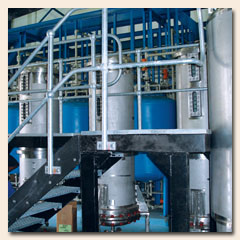
Tongaat Hulett is able to demonstrate proof of ownership on its landholdings pre-dating 1913. Some 4 200 hectares of Tongaat Hulett owned land, of which only 468 hectares is prime development land, is under gazetted land claims. Tongaat Hulett continues to monitor and assist in the settlement of land claims on land supplying its mills in the most appropriate manner to improve future cane supplies.
Operational Performance – Milling and Refining
Tongaat Hulett’s sugar technology leadership was confirmed during the year with milling performance continuing to exceed industry benchmarks measured in terms of critical sugar recovery. Improvements in efficiencies and capacity at the refinery continued, with refined production increasing to 574 000 tons (2006: 504 000 tons).
Domestic Market
Tongaat Hulett continues to optimise the value of the Huletts® brand as the leading sugar brand in South Africa. The brand remains the cornerstone of Tongaat Hulett Sugar’s market positioning and offers a total sweetener solution including a range of high intensity sweeteners. Local market sales of 460 000 tons decreased by 2 percent over the prior year with stockholdings at December 2007 decreasing to 144 000 tons.
An application has been made, with the support of the DTI, to ITAC for an increase in the import tariff reference price from US$330 to US$400 per ton. This will better protect the local market against duty paid imports in times of low world prices.
International Markets
Lower sugar production and carry in stocks resulted in a reduction in raw sugar export volumes to 245 000 tons (2006: 316 000 tons). These were sold at an effective world sugar price of 11,8 US cents per pound (2006: 12,8 US cents per pound) at an average exchange rate of R7,12/US$ (2006: R6,56/US$). Stock on hand at the end of December 2007 reduced to 62 000 tons (2006: 76 000 tons).
Voermol
Having pioneered the production of bagasse and molassesbased animal feeds under the Voermol® brand, this operation continues to be a leader with its range of energy and supplementary feeds, amongst others, as the cornerstone of its offerings to the livestock farming community. This operation is integral to the strategy of optimising value from the molasses and bagasse from the sugar mills and showed an increased contribution to earnings with record volumes in 2007.
Biofuels
In South Africa, the Amatikulu sugar mill represents the most likely opportunity to produce ethanol from the sugar and molasses not required for sale in local markets. The Amatikulu mill currently crushes approximately 1,9 million tons of cane producing 215 000 tons of sugar and 76 000 tons of molasses. The envisaged project could include the construction of an ethanol plant using all of Amatikulu’s molasses and 108 000 tons of export sugar to produce 80 million litres of ethanol as a fuel blend.
Electricity Cogeneration
The Felixton mill is ideally suited to large-scale cogeneration due to its current boiler capacity, which reduces the level of capital spend required. The cogeneration plant that will export 38MW to the national grid in season and 17MW out of season is subject to the success of the tender submitted to Eskom and the subsequent price negotiations. The plant could become operational 22 months after the project is given the go-ahead. In addition, feasibility studies are underway for cogeneration plants at the Amatikulu and Darnall mills.
Mozambique Sugar Operations
Tongaat Hulett's sugar operations in Mozambique consist of the sugar mills and estates surrounding Xinavane and Mafambisse.
Mozambique Sugar Crop, Agriculture and Milling Capacity Expansions
Managing the complexities and interruptions associated with expansion projects, the Mozambique operations were able to produce 108 000 tons of sugar in 2007 (2006: 106 000 tons).
The fast tracking of the Mozambican expansions totalling R1,3 billion continued during the year, building on the solid platform established in the country over the past seven years. Land preparation and the planting of cane at Xinavane are well advanced in order to utilise the expanded factory’s crushing capacity and to capitalise on market reforms in the European Union. The expansions at Xinavane and Mafambisse that will increase the current sugar production capacity of 156 000 tons to 286 000 tons per annum are progressing in accordance with the planned project timelines for the April 2009 start up.
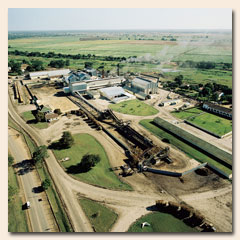
The official opening, by the President of Mozambique, of the Muda Dam situated close to the Mafambisse sugar mill, northwest of Beira, took place during the year. This has facilitated the expansion of a further 2 555 hectares of cane under irrigation at Lamego that will supply the mill with sufficient cane for its current annual sugar production capacity of 82 000 tons. Planting activities in these areas are expected to be completed during 2008 allowing the full tonnage to be available to the mill with effect from the commencement of the 2009 crushing season.
Capitalising on the agricultural conditions, the installed capital base and support from the Mozambique government, the possibility of increasing the Mafambisse mill’s capacity by over 40 percent to 116 000 tons of sugar is being investigated.
The above expansions in Mozambique would result in the production of 320 000 tons of sugar by 2010.
Market Access
Despite delays in the original timetable for the signing of Economic Partnership Agreements (EPA), limited agreements dealing with trade in goods were concluded before the deadline of January 2008. This enables commercial trade arrangements to continue unhindered until September 2009 when the current sugar protocols end and are replaced by the final EPAs that will see an increase in sugar imports to the European Union from 1,6 million tons per annum to 3,5 million tons per annum.
Following the WTO rulings in 2006, the EU will reduce sugar exports into the 40 million ton world sugar market from levels of 5-7 million tons to no more than 1,4 million tons from 2007 onwards. This is coupled with the Everything-but-Arms (EBA) initiative that provides for duty and quota free access to EU markets for Least Developed Countries (LDC) from 2009 and the announced EU sugar market reforms that provide for an institutional reference price of Euro 335,20 per ton until 2015.
Optimisation efforts in attractive markets prior to the implementation of the announced sugar market reforms continued during 2007 with the average export price realisations increasing by 27 percent.
Renewable Energy
In Mozambique, the duty free access into the EU for LDC and ACP countries is of particular relevance. The primary focus of ethanol production in these operations would be for sale to the EU in terms of Mozambique’s preferential market access. Tongaat Hulett is pursuing opportunities for producing biofuel at Cofomosa (Moamba) in Mozambique as part of the expansion plans at Xinavane.
Swaziland Sugar Cane Operation
The Tambankulu sugar cane estate in Swaziland has consistently achieved excellent sucrose yields due to the good soils and growing conditions in the region. These conditions resulted in the production of a record raw sugar equivalent of approximately 58 000 tons during 2007 (2006: 55 000 tons) with world-class sucrose yields of over 18 tons per hectare.
Zimbabwe Sugar Operations
Under the current socio-economic environment, Tongaat Hulett’s immediate strategy in respect of Triangle Sugar and its 50,35 percent stake in Hippo Valley Estates is to manage these operations on a basis that ensures that the infrastructure and skills base is maintained. Programmes are being developed to ensure sugar production is rehabilitated from the 2007 level of 349 000 tons to fully utilise annual installed capacity of 600 000 tons. Particular emphasis is on working with and increasing cane supplies from outgrowers. Ethanol has been produced at the sugar operations in Zimbabwe since 1980, with Zimbabwe as an ACP country enjoying similar preferential market access to attractive European markets, as do Tongaat Hulett’s Mozambique operations.

In 2007, under extremely difficult circumstances, sugar production totalled 349 000 tons (including 156 000 tons from Hippo Valley). Triangle produced 240 000 tons in 2006. The business is presently contending, inter alia, with the extreme effects of hyperinflation, exchange rate devaluation, foreign currency shortages and price controls in Zimbabwe. In 2007, local market sales were at selling prices significantly below world and regional levels. Efforts continue to improve the overall market realisation for sugar produced at Triangle and Hippo Valley, given the effects on domestic market prices within a hyperinflationary economic environment. Current initiatives include:
- Optimising sugar exports,
- Controlling the illegal trade of sugar into neighbouring territories, and
- Managing the impacts of exchange rate policies on access to export proceeds for the importation of supplies as well as dividend repatriation.
Dividends of R53 million were received from Triangle Sugar (2006: R61 million).
Land Reform and Indigenisation Issues
The Indigenisation Bill passed by the Zimbabwe Parliament has yet to be enacted by the president. The bill represents an intention to indigenise the economy but does not empower the responsible minister to force corporations to indigenise within any time period. In its current form, the bill is applicable only to entities that undertake a corporate restructuring through merger, unbundling or divestment.
Integration of Triangle and Hippo Valley Estates
The integration of Triangle with Hippo Valley Estates and the realisation of rationalisation and synergistic benefits in order to improve sustainability and to prepare the entities for the normalisation phase remains an area of focus. Progress to date includes the alignment of policies, procurement and strategic stockholdings, sugar marketing and branding, integration of medical schemes, and sharing of skills and resources through joint management services.
Rehabilitation of Existing Capacities
During 2007, production at the sugar mills of Triangle and Hippo Valley fell to 349 000 tons from the previous 440 000 tons due to delays in the timing of land preparation, harvesting and haulage operations. Plans are in place in 2008 to minimise the effect of these issues on agricultural operations and cane production.
The Zimbabwe land reform programme was undertaken without provision for equipment, working capital, finance and training for the newly settled farmers to grow and harvest the established sugar cane crop. This has lead to yield reductions of 72 percent on outgrower farms, with the crops perishing on 38 percent of these farms. In addition, shortages of agro-chemicals, spares and foreign currency have detrimentally affected all agricultural operations. Current efforts to restore the sugar cane yields are focused on lands recently settled by beneficiaries of the land reform programme and will contribute to production rising to the current installed capacity of 600 000 tons.
The Triangle and Hippo Valley operations provide extension services and support programmes to all qualifying outgrowers of sugar cane, at full cost recovery, through technical training, sourcing of key inputs and finance, and access to surplus farming assets at Mkwasine. A Canelands Trust has been established and low cost finance from the Reserve Bank of Zimbabwe and access to adaptation aid from the EU are being sought to finance a three-year replanting programme on the 11 750 hectares under sugar cane.
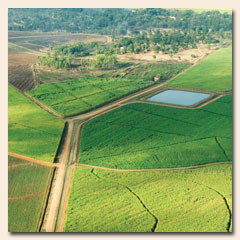
Discussions with government are underway to create joint ventures on the surrounding 4 511 hectares of outgrower land that has perished and was deemed to be non-viable under present allocations. The land would be farmed either as a joint venture with government or as a company estate with the beneficiary being employed for the period, to gain the expertise required. The investment in this respect will be recouped via the harvest of cane. Linked to this process is the resolution of the impasse over the estate at Mkwasine, the security of the other Triangle and Hippo Valley estates from compulsory acquisition and interference and the need for regular reviews of sugar prices as key success factors for the rehabilitation of the raw sugar industry and the future success of land reform.
Land and Property Development
Value Creation from Agricultural Land Conversion
The phases of property markets, and the timing thereof, are difficult to predict and are affected by government approvals and infrastructural investment support, the competitive environment, major developments and market demand. Over a number of years, Tongaat Hulett has developed the ability to influence these processes and reduce its risk whilst optimising the value of its agri-processing operations and landholdings through its profile of:
- Leading development skills and competencies,
- Bulk, concentrated land ownership,
- Planning partnerships with eThekwini and KwaDukuza municipalities,
- Optimising the pace of transition for value in the development cycle,
- The reduction in landholding costs through the continued use of agricultural land up to final transition to property developments,
- A number of land use options,
- Various options for securing cane and maize supplies,
- Opportunities for the land reform process to increase the agricultural base and developmental prospects, and
- The combination of agriculture, agri-processing and property development provides many options of how to satisfactorily deal with land claim issues with Tongaat Hulett able to prove ownership for all developable land dating back to before 1913.
Tongaat Hulett’s land management, land planning and land development strategies support the above-mentioned property development objectives. These strategies provide the appropriate platform for protecting land rights and cane supply to mills, managing land claims, co-ordinated and holistic development planning, realising maximum value from agricultural land, managing the pace of this transition for optimal value, securing timeous development rights and completing approved developments.
Market Review
Capitalising on its platform of prime property developments established over the past 15 years, its prime land with available development rights, strong market conditions and the development pace in the KwaZulu-Natal coastal corridor north of Durban, Tongaat Hulett was able to post record revenue and operating profits from land developments for the fifth consecutive year.
The procurement of development approvals for Umhlanga Ridgeside towards the end of 2007 resulted in an excellent initial sales performance of 160 000 square metres of commercial bulk. Reflecting the high demand for developments in the Umhlanga region, the Umhlanga Ridge Town Centre mixeduse development recorded sales for the year of some 98 000 square metres of bulk, with sales of the remaining saleable stock expected to be concluded in 2008.
The Zimbali Coastal Resort joint venture with IFA continued its strong performance, with 96 percent of the resort sold. IFA commenced construction of its 150-room five-star Fairmont hotel and further progress was made with the planning of the Zimbali Lakes development incorporating the Gary Player designed golf course.
The continued demand for and lack of prime industrial sites lead to good sales at record selling prices in the RiverHorse Valley Business Estate.
The public private partnership with the eThekwini Municipality, Bridge City, achieved good initial sales, which included a new regional shopping centre and represented a positive indicator of strong market acceptance for this new development.

Demand for vacant residential land in the Umhlanga / Mount Edgecombe area during 2007 remained strong despite the rising interest rate environment and the impact of affordability considerations introduced under the requirements of the National Credit Act. The sellout of Izinga Ridge and more than 150 of the potential 569 dwelling unit sites in Kindlewood were the main contributors to the residential sales in 2007.
Operating Environment
The restricted availability of unconditional developable land stock on the North Coast of Durban, coupled with the protracted development approval process and increasing demand has lead to significant increases in selling prices. Market conditions over the next three years are expected to remain firm with the completion of the new International Airport and Dube Tradeport and preparations for the 2010 Soccer World Cup.
Tongaat Hulett continues to work closely with the eThekwini Municipality, its infrastructure BEE equity partner, Ayavuna and the communities surrounding its developments for the mutual benefit of all. Particular emphasis has been placed on building and nurturing government relationships, community and stakeholder engagement, the approvals, planning and provision of infrastructure processes and new marketing and branding strategies. Following this approach good progress is being made towards securing planning approvals for the following developments in 2008:
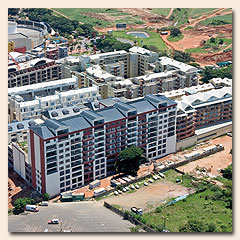
- Sibaya Resort at Umdloti,
- Cornubia, a mixed use node incorporating affordable housing developments,
- Zimbali Lakes, incorporating a resort hotel and a Gary Player designed golf course, and
- The first phase of Shongweni, which in total comprises
970 hectares of developable area on both sides of the N3 freeway linking Durban and Johannesburg, to cater for an extensive commercial node as well as niche residential developments.
SUSTAINABILITY
Tongaat Hulett is committed to sustainable development and the integration thereof into all aspects of its business activities. Safety, health and environment, broad based Black Economic Empowerment, human resources and skills development, employment equity, indigenisation, where applicable, and corporate social investment in the communities in which it operates, continue to be key areas of focus.
Continuing with the programmes implemented in the areas of workplace safety, health and environment, 2007 saw continued improvements in all areas with a number of notable accomplishments during the period.
Improvements in Tongaat Hulett’s safety performance continued in 2007, with the ultimate goal being an injury free workplace. The lost time injury frequency rate reduced to 0,14 from 0,19 in 2006, with a reduction of close to 90 percent over the past five years. Regrettably, three fatal accidents occurred during the year, one at Tongaat Hulett’s Maidstone mill, and two in Mozambique at the Mafambisse facility. These incidents were investigated thoroughly, with action taken to prevent a recurrence of these types of incidents.

The organisation has long been aware of the enormity of the HIV and AIDS pandemic in the areas in which it operates and its potential impact on the associated economies and communities. Comprehensive and holistic health programmes underpinned by prevention, treatment, care and support have been in place at all operations for a number of years in order to reduce the impact of HIV and AIDS. Employees are actively encouraged to participate in voluntary counseling and testing (VCT). During 2007, there was a significant increase in all countries in the number of employees participating in VCT. Support for employees affected by HIV and AIDS continued, with 1 151 employees receiving free anti-retroviral treatment, up from the 390 in 2006.
Tongaat Hulett continues to make good progress in its environmental performance. The principles of ISO 14001 are widely applied, with specific targets being set to facilitate progress in key areas of environmental care and development. As global awareness on the impact of fossil fuels on global warming increases, a number of initiatives and projects, which will have a positive impact on its carbon footprint and greenhouse gas emissions, have been implemented. Ongoing progress is being made in harnessing the potential of sugar cane as a source of renewable energy generation, with new projects on both electricity cogeneration and biofuel production under investigation. The use of gas as opposed to coal as a source of cleaner energy has also advanced within operations.
Tongaat Hulett is determined to realise value for all stakeholders by performing responsibly in relation to the physical and social environment and acting with the highest ethical and moral standards. The principles of sustainable development and good corporate governance and their integration into all aspects of Tongaat Hulett’s business activities are described in more detail in the sustainability and governance reports included as part of this annual report.
BROAD BASED BLACK ECONOMIC EMPOWERMENT
Building on its proud history of numerous meaningful and sustainable past broad based Black Economic Empowerment (BEE) initiatives for the benefit of all stakeholders, the corporate transactions completed in 2007 included a 25 percent BEE equity participation in Tongaat Hulett. This equity participation includes strategic partners, the disadvantaged communities surrounding its property developments and the small-scale cane grower communities surrounding the South African sugar mills. In recognition of the key roles played by employees in the sustainability of Tongaat Hulett, the equity participation also includes BEE management and employee share ownership schemes.
Following the successful introduction into Tongaat Hulett during 2007 of BEE equity partners, further recognition of the progress over a number of years was formalised with the accreditation by NERA of Tongaat Hulett as a Level Three Contributor. Highlights of the accreditation included:
- Confirmation of a score of 21,63 points (including 2 bonus points) out of 20 for the ownership element of the scorecard,
- A full score in the area of corporate social responsibility reconfirming Tongaat Hulett’s continued commitment to building and enhancing the quality of life of people, with an emphasis on previously disadvantaged communities within which the company operates, and
- A score of 13,73 points out of a possible 15 in the area of enterprise development reflecting the activities undertaken to assist with the development of black owned medium sized businesses. Tongaat Hulett’s Medium Scale Farm Programme resulted in the transfer of 98 farms, comprising 11 871 hectares of land, to previously disadvantaged emerging farmers.
Tongaat Hulett values the new dimensions that a diverse human resource base brings to its businesses. A strong employment equity culture has been fostered over many years, and actions are continuing to improve the representation of designated groups, with particular emphasis on Africans, women and people with disabilities. Currently, black employees fill 50 percent of management, and 77 percent of skilled and supervisory positions. Within the South African operations, 58 percent of the 450 graduates are black employees, with women constituting 33 percent.
During 2007, as part of the programmes to encourage the development of small black owned business, the first intake of emerging black farmers began their practical training at Tongaat Hulett’s Kliprivier maize farm.

CONCLUSION
Outlook
As the business moves forward, there are a number of relevant factors and actions underway, including:
- Exchange rate movements that affect local pricing and costs, as well as Tongaat Hulett’s exports.
- Substantial cane expansions in Mozambique will be completed to enable sugar production above 260 000 tons in 2009.
- The South African sugar operations’ focus includes new cane procurement initiatives, together with ongoing drives to increase competitiveness on costs, efficiencies and yields. The small 2007 crop will affect the results in the first half of 2008. A reasonable 2008 sugar crop in South Africa and higher international sugar prices would have significant benefits for results in the second half of 2008.
- Electricity cogeneration supply agreements are likely to be concluded during the year.
- The attention in Zimbabwe will be on restoring local prices to regional equivalents and on building towards full available capacity utilisation of 600 000 tons per annum, with particular emphasis on working with and increasing supplies of cane from outgrowers.
- Going into 2008 with a limited stock of unconditional developable land, the immediate focus is on being able to proceed with Zimbali Lakes, Sibaya at Umdloti, Umhlanga Ridge Town Centre residential precincts and to accelerate the planning process in respect of Cornubia at Mt Edgecombe North, Shongweni and the land surrounding the new international airport. The development process around this new airport at La Mercy, Tongaat, will highlight the increasing value of land in that area.
- Higher international maize prices coupled with improved local planting intentions and good early season growing conditions have resulted in local maize prices moving closer to export parity levels, which should benefit the starch operation during the second half of 2008.
Overall, sustained growth in profit from operations is expected in the 2008 year and this, together with the non-recurrence of the significant once-off corporate structuring costs incurred in 2007, should lead to a considerable increase in headline earnings.
Acknowledgments
I wish to pay tribute to the employees of Tongaat Hulett and to thank them for their continuing dedication and commitment. Working together, we have established a competitive platform that will stand us in good stead into the future.
In January 2008, Gordon Hibbert, Managing Director of Tongaat Hulett Developments, passed away following a courageous battle against cancer. Gordon who joined the organisation in 1972 was a highly respected colleague and friend and will be missed by all. His vision and dedication to the organisation is reflected in the developments surrounding Umhlanga and on the North Coast of KwaZulu-Natal. Our sincere condolences are extended to his wife Janetta, his son Stuart and daughter Michelle.
The support and guidance that we have received from the Chairman, Cedric Savage and the Board is highly valued. Tongaat Hulett has benefited from their wise counsel and experience over a number of years.

Peter Staude
Chief Executive Officer
Amanzimnyama
Tongaat, KwaZulu-Natal
21 February 2008




